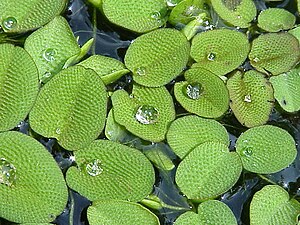Salvinia
| Salvinia | |
|---|---|

| |
| Salvinia natans | |
| Scientific classification | |
| Kingdom: | |
| Division: | |
| Class: | |
| Order: | |
| Family: | |
| Genus: | Salvinia |
| species | |

Salvinia, a genus in the family Salviniaceae, is a floating fern named in honor of Antonio Maria Salvini, a 17th Century Italian scientist. The genus was published by Séguier, in Pl. Veron. 3: 52. 1754. About ten species exist.
Salvinia is related to the other water ferns, including the Mosquito fern Azolla. Recent sources include both Azolla and Salvinia in Salviniaceae, although each genus was formerly given its own family.
Salvinia, like the other ferns in order Salviniales are heterosporous, producing spores of differing sizes. However, leaf development in Salvinia is unique. The upper side of the floating leaf, which appears to face the stem axis, is morphologically abaxial (J. G. Croxdale 1978, 1979, 1981).
The plants pose a particular hindrance on certain lakes, having choked off much of the water in Lake Bistineau near Doyline in Webster Parish, Louisiana. Other problems have persisted in a second Webster Parish site, Caney Lakes Recreation Area.[1]
Distribution
Mostly tropical, North America, Mexico, West Indies, Central America, South America, Eurasia and Africa, including Madagascar.
Description
Small, floating aquatics with creeping stems, branched, bearing hairs but no true roots. Leaves in whorls of 3, with 2 leaves green, sessile or short-petioled, flat, entire, and floating, 1 leaf finely dissected, petiolate, rootlike, and pendent. Submerged leaves bearing sori that are surrounded by basifixed membranous indusia (sporocarps); sporocarps of 2 types, bearing either megasporangia that are few in number (ca. 10), each with single megaspore, or many microsporangia, each with 64 microspores. Spores of 2 kinds and sizes, both globose, trilete. Megagametophytes and microgametophytes protruding through sporangium wall; megagametophytes floating on water surface with archegonia directed downward; microgametophytes remaining fixed to sporangium wall. The small, hairlike growths, known as microgametical follicles, are not known to have any productive function, and are currently a biological mystery.
Economic Uses
Giant salvinia (Salvinia molesta) is a commonly introduced invasive weed in warm climates. It grows rapidly and forms dense mats over still waters. It is native to South America. A tiny weevil, Cyrtobagous salviniae, has been used successfully to control giant salvinia.
S. natans is commonly used in aquariums as a decorative floating plant.[1]
References
- ^ ""Lake Bistineau Salvinia Information Page"". lakebistineau.com. Retrieved August 25, 2009.